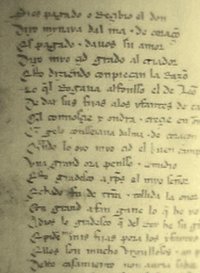Cantar de Mio Cid
|
|
El Cantar de Mio Cid is the oldest conserved Spanish cantar de gesta. Formerly, it was transmited only orally, but in 1207 it was written down by Per Abad. This copy is held as part of a 14th century codex in the Biblioteca Nacional (National Library) in Madrid. However, it is incomplete. The first page and a then two others in the middle are missing. It is written in mediaeval Castilian, the ancestor of modern Spanish.
The title we give it now is a modern invention: we do not know exactly what the original poet called it. Some call it El Poema del Cid on the grounds that it is not a cantar but a poem made up of three cantares. The title has been translated into English as The Lay of the Cid and The Song of the Cid. Some English translations include the verse translation of W.S. Merwin and prose translation of Rita Perry and Janet Hamilton.
| Contents |
The Story
Being based on a true story, it tells the story of a Spanish hero El Cid or El Campeador, whose true name was Rodrigo (or Ruy) Díaz, during the Reconquista, or reconquest of Spain from the Moors. El Cid married the sister of the king Alfonso VI, Jimena Díaz, but for obscure reasons (according to the story, he made the king swear he did not ordered the murder of Alfonso's brother), he fell into the disfavour of the king and had to leave his home country Castile.
To regain his honour, he participated in the battles against the Moorish armies and conquered Valencia. By these heroic acts he regains the confidence of the king and his honour is saved. His two daughters then marry the infantes (princes) of Navarre and Aragon.
The entire work, consisting of more than 3700 verses, is conventionally divided into three parts:
Cantar del Destierro
El Cid has to leave Castile and fights with the Moorish king of Zaragoza until he gets to Valencia.
Cantar de las Bodas
El Cid conquers Valencia. After Cid asks the king to forgive him, he agrees and Cid marries his two daughters to the infantes of Carrión.
Cantar de la Afrenta de Corpes
The infantes of Carrión offend and abandon their wives. Once more, El Cid has to gain his honour back, so he asks the court of Toledo for justice. Then he remarries his two daughters to the infantes of Navarre and Aragon.
Authorship
The whole work is anonymous, but there is a theory that it was composed by two people. One from San Esteban de Gormaz, Soria, who tried to portray the story more realistically, and other from Medinacelli who adds some more novelesque lines.
Extract
These are the first two stanzas that we have. The format has been slightly regularised.
De los sos oios tan fuertemientre llorando, Tornava la cabeça e estavalos catando; Vio puertas abiertas e uços sin cañados, alcandaras vazias, sin pielles e sin mantos e sin falcones e sin adtores mudados. Sospiro Mio Cid, ca mucho avie grandes cuidados. Fablo mio Cid bien e tan mesurado: «grado a ti, Señor, Padre que estas en alto! »Esto me an buelto mios enemigos malos.» Alli piensan de aguiiar, alli sueltan las rriendas; a la exida de Bivar ovieron la corneia diestra e entrando a Burgos ovieronla siniestra. Meçio Mio Cid los ombros e engrameo la tiesta: «¡Albricia, Albar Fañez, ca echados somos de tierra! »Mas a grand ondra torneremos a Castiella.»
Links
For more information, read the article on El Cid Campeador.et:Laul minu Cidist es:Cantar de Mío Cid

